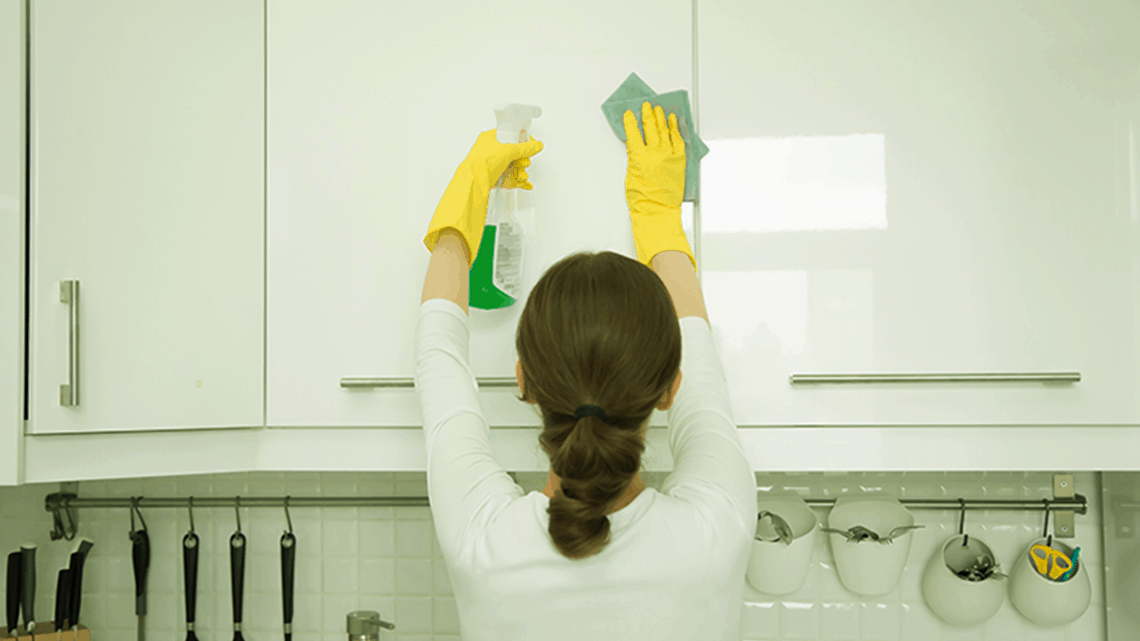Cleaning kitchen cabinets, a comprehensive guide
That tacky glue of grime and dirt often ruins your kitchen cabinets without you even knowing, stop the culprit in its tracks by deep cleaning…
The idea of deep cleaning the kitchen cabinets is not a flawed one, just something that requires accurate product information and the heart to work. Our kitchen cabinets take steady toll of heat and grease throughout the day and removing stains from such surfaces is not a child’s play. It is de rigueur for common households to keep the worktops and other kitchen surfaces clean and shining. However, kitchen cabinets don’t get cleaned in the same fashion. Making erroneous assumptions about kitchen cleaning can lead to wide-spread-detrimental-effects and therefore, should be avoided at any cost.
Around the clock, cooking residues, splatters, spills, and dirt are collected by our cabinets which can then, over time, turn in to a sticky monster that just wouldn’t let go of your cabinets easily. Kitchen cleaning is directly proportional to your will of eliminating the grime off your counters and keeping those surfaces safe from germs because this is how it all works out in the end - If you are willing to put in hard work only then you’d get the results.
Yes, you can always hire kitchen cleaning services for an incomparable experience but you can’t call them up every time you see your cabinets becoming lifeless, you need to work it out yourself and we are here to guide you through the process. Apart from dirt, microorganisms may also make home on those dirty handles and knobs making you and your family susceptible to unobserved diseases. All your cabinets need is a good old fashioned deep clean. The widely known deleterious effect of bleach makes it an unsuitable candidate when it comes to cleaning kitchen surfaces because surely you don't want your kitchen surfaces to become dilapidated.
The frequency
First of all, you need to map out how frequently do these cabinets need to be cleaned? Determining the cleaning frequency is indispensable for effective results. Experts recommend wiping down the exterior of your kitchen cabinets once or twice a week but the interiors should be deep cleaned every few months. You don’t need to get in a frenzy over emptying or rearranging the whole kitchen because this is not required as you should be adopting one cabinet at a time approach.
This will give you the time to plan out other cleaning activities simultaneously. Don’t try cleaning everything at once, instead make a list of things you have to do and then check out the surfaces that are now cleaned. This way you’d be able to cover everything in a systemic manner and won’t go in circles. For instance, sweeping and mopping kitchen floors should be done only once in one cleaning cycle, if you won’t mark it then doubt will make you go at the floors again and again, thereby wasting your time.
What will you need?
You’ll be needing a dish soap, cleaning cloth, kitchen cleaner, baking soda, and hot water. Vacuum cleaner and vinegar are optional. This inventory is enough for you to ace the kitchen cleaning process leaving behind an immaculate kitchen. You should try and keep extra cloths as you might be needing more than one at times.
Different approaches
There are a lot of cabinet types from painted wood to stainless steel and most of these types can be cleaned by using a mixture of hot water and liquid dish soap. The dish soap here works as a degreaser and helps decontaminate the exterior by cutting off tough buildups and food smudges. You can also use a multipurpose cleaner to clean your cabinets but it’s important to read the label first because suitability of such cleaners needs to be checked else your beloved wood work can end up being damaged.
Clean the exterior first
You should always start your way from the top and move down. For cabinets that are made up of a sturdy and resisting material, spraying the cleaner or disinfecting solution directly won’t be a problem but for other cabinets you must spray the solution on the cloth and then use it. Don’t miss out on rinsing thoroughly before using another cloth. Utilization of glass cleaner to clean cabinets that are mirror faced is a good choice and if you can, remove hardware from the cabinets prior to cleaning because discoloration may pose a real threat to your kitchenette beauty.
How to clean the interior?
Number one thing to do would be emptying the cabinets. There can be a lot of food residue and grease crumbs inside your cabinet and you need to vacuum for a better cleaning experience prior to wiping down. Wash the interior with a mild solution and then change cloths. Now wipe again to make sure you are not leaving behind any water traces, again using a surface cleaner might be a good choice but read the label first.
As for what’s inside those cabinets, clean and wipe down cans that appear dusty and run a damp rag across the surfaces. Don’t leave behind any expired items and dry the placing surface aptly before placing back all the cans and containers. Once you are done with all this, turn your head around and look for anything that’s left out. If there’s nothing left then congratulations, you are just done with deep cleaning your kitchen cabinets.
So this is all about cleaning your cabinets, if you still have any questions, please let us know. We’ll be more than happy to help you out.
